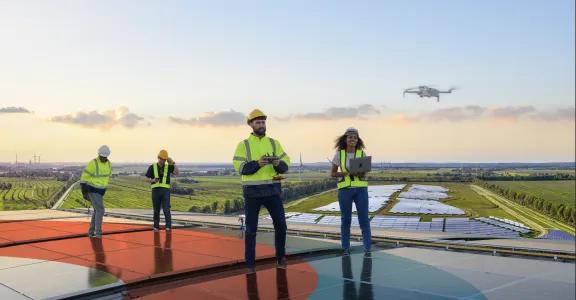The key to a Factory of the Future
Anyone can buy technology. It’s what you do with it that makes the difference
With the Make The Future process, Agoria and Sirris have set up an intensive programme to guide companies toward the status of Factory of the Future. This process includes seven transformations that help companies make their production processes future-proof. In this series of interviews we dive deeper into each transformation, together with an expert. This time we’re talking with Peter ten Haaf about the Advanced Manufacturing transformation.
What is Advanced Manufacturing?
Hello Peter, what exactly is the Advanced Manufacturing transformation?
Peter ten Haaf: "In this transformation it’s about technology: how is technology being used within production, and is it used optimally? The first question we ask is whether the technology used is in fact the technology best suited to the production. Then we see whether it is being applied properly and whether employees use the technology optimally to gain a competitive advantage.
That doesn’t necessarily mean that companies must always implement the newest technologies. Sometimes a well-equipped welding station can be just as state-of-the-art as the newest machine. What counts is how companies make smart use of technology within their production process."
How do you proceed for Advanced Manufacturing? A well-thought-out approach to technology
Many companies think that they must invest heavily in new machines to become a Factory of the Future. Is that right?
Peter: It’s important that we not express a preference for a certain technology within this transformation. We don’t want to push anyone in a certain direction, or oblige them for example to go get a robot or a 3D printer. We look at the production of the factory concerned, and ask the question whether all the resources are being used for it that are available today. And if they’re not being used, we want to know why not. Because sometimes there can be a good reason for that.
What is needed varies from industry to industry. In the chemical sector you have a continuous system in which everything is connected with pipes and so forth. That’s one flow, while a company that makes mechanical parts will instead consist of different work stations separate from each other.
Practical examples of Advanced Manufacturing
Do you have examples of how this transformation works in practice?
Peter ten Haaf: "Take a company in West Flanders that makes injection-moulded parts, like the stoppers on spray cans of shaving foam. The factory faced a logistics challenge: transporting and manually filling machines with plastic pellets.
After analysing and optimising the process, we introduced an automated solution. Autonomous vehicles were used to transport bags with pellets and automatically fill machines. Consequently a manual, low-added-value process was automated, which significantly improved the efficiency and ergonomics."
And what about repetitive tasks?
Peter: It can also involve connecting, with which we go toward the Digital and Smart Factory transformations, because of course Advanced Manufacturing has a link with that, certainly when it comes to the use of robots. There is a lot of repetitive manual work like polishing or deburring that can be taken over by such machines.
The advantages of Advanced Manufacturing
In your opinion, what are the greatest advantages that Advanced Manufacturing entails?
Peter: The idea of course is to get a competitive advantage over your competitor via the technology. The right use of technology in production offers numerous advantages, including:
- Shorter throughput times: Faster production times and more efficient workflows.
- Lower cost price per product: Optimised processes reduce waste and costs.
- Higher reliability and quality: Automation helps minimise errors.
- Greater flexibility: Production lines can be adjusted to market demand faster.
The real key to success lies in the right combination of technology, process optimisation and employee involvement.
We call those SMEs that see the customer, to whom you can respond with your machinery. A factory of the future will do that so that a unique advantage is achieved, such as a very short delivery time, a very competitive price, or ultimate flexibility so that the customer can ask anything he wants from the product and have it delivered. You must ensure that your machinery can respond along those five lines and so find an exceptional position.
Challenges in the implementation of Advanced Manufacturing
What are the major challenges in that transition to Advanced Manufacturing?
Peter ten Haaf: "A structured approach is essential. Companies must draw up a clear technological roadmap. This includes:
- Following evolutions in technology and identifying relevant developments.
- Planning investment trajectories to implement the right technologies step by step.
- Employee training and involvement, so that employees use technology optimally.
A common mistake is investing in expensive technology without the right training. A hypermodern milling machine has little value if only half of its capabilities are used. Successful companies ensure that their employees are trained and actively involved in the implementation."
What do you think is the key to success in Advanced Manufacturing?
Peter ten Haaf: "Advanced Manufacturing offers companies the opportunity to optimise their production processes and gain a competitive advantage. The key lies not just in technology, but in how it is applied and integrated."
Read about the other transformations of the Make The Future programme:
Make the Future: Your Pathway to a Factory of the Future >
Transforming to Digital Factory >
Discover the Make the Future programme!
Want to know more about what Make the Future can do for your business? Find out here how this programme from Agoria and Sirris can help you transform your manufacturing company into a sustainable and innovative market leader.
For more information, contact our expert Peter ten Haaf, or arrange a no-obligation appointment for an initial analysis of your business.


